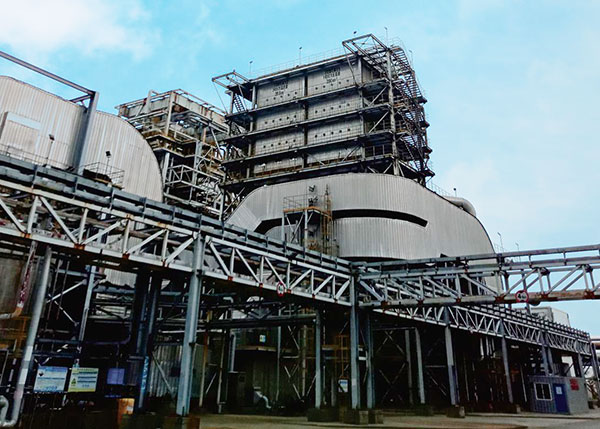Fangxin SCR Denitration Catalyst: Introduction to the Composition of Smoke Denitration Catalysts
Publishdate:2023-03-06 Views:162
Anhui Catalyst for flue gas denitrification,At present, commercial SCR catalysts are mainly based on TiO2, with V2O5 as the main active ingredient and WO3 as the main active ingredient. MoO3 is an auxiliary component for antioxidant and detoxification. There are three types of catalysts: plate, honeycomb, and corrugated plate.
The catalyst is based on a metal mesh rolled from stainless steel metal plates, and a mixture of TiO2, V2O5, and other substances adheres to the stainless steel mesh. After pressing and forging, the catalyst plate is assembled into a catalyst module.
Honeycomb catalysts are generally homogeneous catalysts. TiO2. V2O5, WO3, and other mixtures are extruded using porcelain extrusion equipment to produce catalyst elements with a cross-section of 150mm x 150mm and different lengths, and then assembled into a standard module of catalyst elements with a cross-section of approximately 2mm.
The manufacturing process of corrugated plate catalysts generally uses glass fiber reinforced TiO2 as the substrate, and active ingredients such as WO3 and V2O5 are impregnated on the catalyst surface to improve catalyst activity and reduce SO2 oxidation rate.

A brief history of the development of flue gas denitrification catalysts:
Catalysts are a part of SCR technology, determining the denitrification efficiency and economy of SCR systems. Its construction cost accounts for more than 20% of the cost of flue gas denitrification engineering, and its usage cost accounts for more than 30%. In recent years, developed countries such as the United States, Japan, and Germany have continuously invested a large amount of manpower, material resources, and funds to develop efficient and low-cost flue gas denitrification catalysts. They attach great importance to the protection of intellectual property rights in catalyst patent technology, technology transfer, and production licensing processes.
The initial catalysts were metal catalysts such as Pt Rh and Pt, using integrated ceramics such as alumina as a medium, which had the characteristics of high activity and low reaction temperature. However, the expensive price limited their application in power plants.
Therefore, since the late 1960s, Hitachi, Mitsubishi, and Takeda Chemical have developed TiO2 based catalysts and gradually replaced Pt Rh and Pt series catalysts. These catalysts are mainly composed of V2O5 (WO3), metal oxides such as Fe2O3, CuO, CrOx, MnOx, MgO, MoO3, NiO, or mixtures that act in conjunction with TiO2. Al2O3, ZrO2, SiO2, and activated carbon (AC) are used as media to undergo oxidation reactions with liquid ammonia or urea oxidants in the SCR system, and have become the mainstream catalyst products used in SCR denitrification projects in power plants.
Anhui Catalyst for flue gas denitrification,At present, commercial SCR catalysts are mainly based on TiO2, with V2O5 as the main active ingredient and WO3 as the main active ingredient. MoO3 is an auxiliary component for antioxidant and detoxification. There are three types of catalysts: plate, honeycomb, and corrugated plate.
The catalyst is based on a metal mesh rolled from stainless steel metal plates, and a mixture of TiO2, V2O5, and other substances adheres to the stainless steel mesh. After pressing and forging, the catalyst plate is assembled into a catalyst module.
Honeycomb catalysts are generally homogeneous catalysts. TiO2. V2O5, WO3, and other mixtures are extruded using porcelain extrusion equipment to produce catalyst elements with a cross-section of 150mm x 150mm and different lengths, and then assembled into a standard module of catalyst elements with a cross-section of approximately 2mm.
The manufacturing process of corrugated plate catalysts generally uses glass fiber reinforced TiO2 as the substrate, and active ingredients such as WO3 and V2O5 are impregnated on the catalyst surface to improve catalyst activity and reduce SO2 oxidation rate.

A brief history of the development of flue gas denitrification catalysts:
Catalysts are a part of SCR technology, determining the denitrification efficiency and economy of SCR systems. Its construction cost accounts for more than 20% of the cost of flue gas denitrification engineering, and its usage cost accounts for more than 30%. In recent years, developed countries such as the United States, Japan, and Germany have continuously invested a large amount of manpower, material resources, and funds to develop efficient and low-cost flue gas denitrification catalysts. They attach great importance to the protection of intellectual property rights in catalyst patent technology, technology transfer, and production licensing processes.
The initial catalysts were metal catalysts such as Pt Rh and Pt, using integrated ceramics such as alumina as a medium, which had the characteristics of high activity and low reaction temperature. However, the expensive price limited their application in power plants.
Therefore, since the late 1960s, Hitachi, Mitsubishi, and Takeda Chemical have developed TiO2 based catalysts and gradually replaced Pt Rh and Pt series catalysts. These catalysts are mainly composed of V2O5 (WO3), metal oxides such as Fe2O3, CuO, CrOx, MnOx, MgO, MoO3, NiO, or mixtures that act in conjunction with TiO2. Al2O3, ZrO2, SiO2, and activated carbon (AC) are used as media to undergo oxidation reactions with liquid ammonia or urea oxidants in the SCR system, and have become the mainstream catalyst products used in SCR denitrification projects in power plants.




